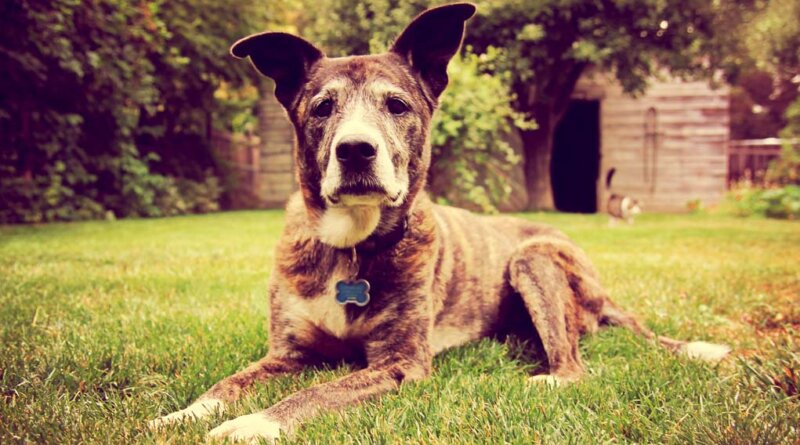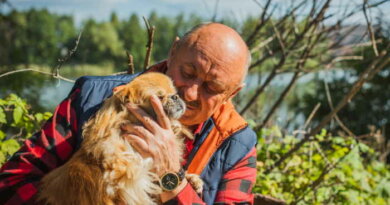8 Vet’s Tips on How to Care for Senior Dogs – Top Dog Tips
Our pets today live much longer than they did a few decades ago, thanks to advancements in veterinary care and a variety of medicine, tools and treatments available.
Unfortunately, while our senior dogs get a few extra years of life, they’re likely to suffer from a number of health issues, which means pet owners must adjust their care routine and find ways to accommodate an older dog’s lifestyle.
Here are a few tips to care for your senior dogs and make them more comfortable.
Proper Bedding
Just like people, older dogs can suffer from arthritis, a degenerative change in the joints that leads to pain and loss of mobility.
Sleeping on the floor or on a thin blanket can make old joints even creakier and can cause unnecessary pain.
Many senior dogs sleep more as they age and sleep becomes much more important for an older dog.
This makes proper bed selection crucial.
When selecting a dog bed for senior dogs, pick one that is large enough for your dog to stretch out on, that will support his weight and fits his sleeping patterns/temperament.
Some beds are significantly better than others. For example, orthopedic dog beds can help relieve discomfort and encourage more restful sleep.
An orthopedic dog bed is particularly beneficial for older dogs with arthritis or hip dysplasia.
These benefits include additional support and comfort for the dog’s muscles and joints, along with better weight distribution when your dog is lying down.
A pet bed warmer or heating pad can help to relieve the ache your arthritic dog is feeling.
The heat will stimulate sore muscles to relax.
Always remember to follow the instructions on the heating pad and use with caution; they’re best for winter.
Similarly, for summers, a cooling bed or mat may help relieve joint pain, among other cooling mat benefits.
If your dog refuses to use the dog bed he currently has, switch to a more comfy model.
Encourage him to use it by placing treats in and around the new bed.
Placing the bed in a favorite home location can also encourage better rest.
Carpeting and Flooring
As a veterinarian, I have seen many dogs injure themselves from falling on slippery surfaces. These surfaces are often tile or hardwood flooring in homes.
Most of the time, the injuries are minor bruising and uncomfortable muscle strain but falls can cause severe injuries such as ligament tears and broken bones, especially for older dogs.
If your dog keeps falling or has difficulty standing sitting or lying down, choose better flooring.
There’s even science behind it explaining which ones are safer for dogs.
Large area rugs can be temporarily placed in areas where your dog spends most of his time. Smaller rugs can be used in areas that are oddly shaped.
Anti-skid bottoms can be adhered to the rugs to prevent slipping; some rugs even have an anti-slip bottom already attached.
Staircases that are used frequently can also be temporarily covered with carpet to help prevent falls down the stairs.
Using area rugs to help your dog’s mobility will greatly improve his quality of life and prevent painful (and expensive) injuries.
Area rugs are simple to clean if your senior dog has occasional accidents and can be vacuumed just like regular carpeting.
If you hate carpet, remember that the area rugs won’t be there forever, and neither will your beloved, so it is worth making the change for the dog’s sake.
Home and Vehicle Access
Limited or slow mobility due to muscle atrophy and/or arthritis can make staircases, beds and vehicle access almost impossible for senior dogs.
Jumping up onto a bed, into a car or onto a favorite sofa can also be risky if not painful, leading to ligament tears and could even predispose a weak back to a blown disc in a dog.
Save your own and your pet’s back by finding better ways to help your dog get onto beds, climb stairs and into vehicles.
There are tools to help with that.
Folding ramps are easiest for large dogs needing vehicle access. Check the size and weight limits for each portable ramp or pet stairs before making your purchase.
The safest models have a “non-skid,” easily-cleaned surface on the ramp and each stair.
Some dogs may seem hesitant to use stairs at first, there’s a way to quickly teach them.
For older large dog, a permanent access ramp is a good idea.
Wooden, concrete or stone ramps can be an affordable DIY weekend project or built by local contractors.
It is recommended to build the ramp large and sturdy enough for wheelchair use. Older dogs and humans can both benefit from this investment, as handicap access to homes is desirable for many home buyers today in case you ever need it yourself, or wish to sell your home.
You’d be surprised how many people are looking for houses like this.
Potty Troubles
Fecal and urinary incontinence can happen as your dog ages. Medical issues with digestion or Cushing’s disease can make “holding it” problematic.
Loss of housebreaking can also be a sign of cognitive dysfunction (“doggie dementia”).
If your dog is having “accidents” in the house, have him examined by your veterinarian.
Sometimes these issues cannot be treated, such as severe arthritis in the spine, which can lead to incontinence, or if your dog has an inoperable tumor.
Using potty pads in the locations where your dog has accidents can keep things clean and lead to less work and embarrassment.
If mobility is the issue and walking a long distance to go outdoors (such as living in a high-rise apartment) predisposes accidents, you can re-train your dog to use potty pads indoors on a drip pan.
Using faux-turf on a balcony or in your garage can be a good option as well; there are doggie litter boxes for this.
Many dogs seem to like the feel of the fake grass under their feet and transition to this new routine easily.
Dog diapers may be another option.
Use treats and praise when re-training your senior pooch to potty indoors. If your dog has an accident, it’s likely your pet isn’t happy about that either.
Scolding him or showing him that you are upset can make the problem worse.
Show compassion and accommodate your senior the dog best that you can. Always keep in mind that it is not your pet’s fault and he is not doing it on purpose.
Feeding Conditions
Arthritis in the neck and back can make eating on the floor a chore for older pets. If your dog becomes a messy eater or is spilling his water all over the place – consider elevating the dog food bowl and water dishes either manually or buy elevated bowls.
Some dogs begin to eat their dog food and drink water lying down in order to avoid the discomfort of bending their nose to the floor.
If you notice your senior dog lying down to eat when he has never done it before, that is a major sign that he is in pain while standing up to eat.
Elevating the dog’s food and water bowls reduces their risk of developing gastric dilatation-volvulus (more commonly known as bloat).
Bloat is when the stomach fills up with air and puts pressure on the other organs and the diaphragm.
The pressure on the diaphragm makes it hard for the dog to breathe.
The air-filled stomach also puts pressure on the large veins in the abdomen, which prevents blood from returning to the heart.
Filled with air, the stomach can also rotate on itself, pinching off its own blood supply.
Bloat is a serious and life-threatening condition.
Bloat is not just a large-dog problem; as your dog ages, digestion can also slow, predisposing any dog to bloat.
It is a good idea to reduce your dog’s risk in any way you can.
Elevating the food dish helps to reduce how much air your dog swallows as he eats, among other benefits, but certain claims about raised food bowls are myths.
Use Dog Support Sling, Nail Care, Dog Shoes
If your dog has difficulty moving around the house or even using a pet ramp, a hip sling with a handle can make a huge difference.
Traction control socks or dog shoes can also be beneficial if new carpeting is not an option.
Keeping your dog’s nails trimmed short can also improve his traction on slippery footing.
Nail care should be performed at home, at the grooming salon or by your veterinarian every 4-6 weeks.
Get Physical Exercise
The thing I recommend most to parents of senior dogs is to remember the things that make your dog happy and active.
As dogs age their metabolism slows down and they start to lose muscle mass.
It’s natural, as your dog ages, just like us, if they eat the same calories but don’t get the appropriate exercise, well it can cause obesity.
So figure out how to keep your aging dog healthy and active to prevent weight gain.
If your dog enjoys swimming, let him swim.
If he needs help, invest in a life jacket and get in the water with him.
Not only will this greatly increase your senior dog’s quality of life and alleviate joint pain, but it will also add to the bond that you and your senior pet share.
Keeping your older dog’s routine as normal as possible will only benefit the dog.
If your Fido is still fairly spry, but you notice him slowing down a little, you can try helping him exercise to stop the muscle deterioration that is common in older animals.
While pet owners prefer to leave their old dogs alone to rest, vets always warn that an occasional good exercise routine will be much more beneficial than consistent rest.
Exercise balls are common in human gyms, but did you know they can be a big help for canines too?
For example, balancing your dog’s front paws on an exercise ball can help to strengthen the muscles in his back legs.
Similarly, you can install a dog treadmill at home for easier access to training.
Be sure to do some research, consult your veterinarian, and talk with an agility trainer before trying this type of rehabilitation at home because done incorrectly, it can be damaging.
Have A Dental Care Routine
This is important at any stage of live. Clean teeth is just as important to a senior pet’s health as managing joint problems and physical activity.
We recently lost our sixteen year old dachshund because of periodontal disease.
It was one of those end-of-life decisions where we couldn’t afford the surgery, but if we did nothing, he would suffer much more than he already had.
What was the problem? We never brushed his teeth ourselves or had someone else do it.
Don’t put yourself in that position like we did.
Fortunately, if you don’t feel comfortable doing it yourself, hopefully there is a local vet that will do a non anesthetic dental cleaning.
Also, there are businesses that will come to you and do it WITHOUT ANESTHESIA.
I know, I know, calm down; it’s still a little pricey, but significantly more affordable than having a vet do it and a no-brainer compared to the previous situation we were in.
READ NEXT: How to Make and Use A Rear Leg Sling for Senior Dogs












